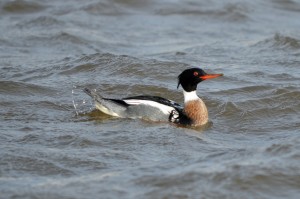 This is just about the best time of the year to see ducks as there are sometimes huge numbers over wintering in the Highlands from their northern breeding grounds. The coasts are the best places and on a good day at some of the “hotspots” you could see around ten species. Some will be in large flocks such as wigeon and you cannot mistake these as the whistling call notes of the males are dominant. Other large flocks include eiders and it is well worthwhile looking closer at eider flocks as you may be lucky enough to see a king eider amongst them. Smaller flocks include those of pintail and teal and some normally include only a handful of ducks such as goldeneye and goosanders.
This is just about the best time of the year to see ducks as there are sometimes huge numbers over wintering in the Highlands from their northern breeding grounds. The coasts are the best places and on a good day at some of the “hotspots” you could see around ten species. Some will be in large flocks such as wigeon and you cannot mistake these as the whistling call notes of the males are dominant. Other large flocks include eiders and it is well worthwhile looking closer at eider flocks as you may be lucky enough to see a king eider amongst them. Smaller flocks include those of pintail and teal and some normally include only a handful of ducks such as goldeneye and goosanders.
There are also popular names for most of the ducks that are descriptive of the way or where they feed. A delightful one is called the dabblers and these are ducks such as the mallard and teal that upend in the shallows for food that includes aquatic plants and seeds. The group called the diving ducks include tufted ducks and pochard and, as the name suggests, they dive under the water for food, mainly aquatic plants but also water snails and even small fish. All these collective words describe their feeding behaviour but another group with large numbers of species are named after where they normally can be found in the winter. These are the seaducks and they include long-tailed ducks, eider and the scoters. One small group that is named after their appearance are the sawbills that include the goosanders, red-breasted mergansers and smew.
The name sawbills comes from their beaks as they have serrated edges to the insides of the beak which enables them to easily grab and hold onto fish which is their main food although they will eat small mammals and insects. The smew is the rarity of the three as they do not breed in the UK and very few come to us for the winter from their northerly breeding grounds. Small numbers breed in Norway and Sweden but most breed in northern and eastern Siberia. The much larger goosander and red-breasted merganser breed in Scotland and their numbers are roughly the same being around 2,300 pairs. Both can be seen on the sea in winter although they cannot be classed as seaducks as they also occur inland in winter albeit in small numbers.
As with most other members of the duck family the females are drab compared with the males being mainly barred shades of brown. This is because the females need camouflage against predators if they nest on the ground. In contrast the males are very colourful and none more so than the male red-breasted mergansers although you have to be fairly close to see the array of colours. The photograph, with the sun gleaming on the plumage, really highlights the various striking colours.
The problems with red-breasted mergansers and goosanders is that they eat fish. For example, studies on the red-breasted mergansers indicate that they eat sand eels and eels and they have been even known to eat lampreys. The problem lies in the fact that they will also eat young salmon and trout. This leads into conflict with fisheries and anglers and for many years licences have been issued to shoot/kill both red-breasted mergansers and goosanders. Interestingly, there is NO evidence that either of these sawbills adversely affect fish stocks. There is an interesting variation in breeding behaviour between the red-breasted merganser and the goosander. The former normally nest on the ground so is prone to predation by foxes, hooded crows etc. The goosander tends to nest in holes of trees and this means they will also utilise nest boxes.
Tags: highland birds
